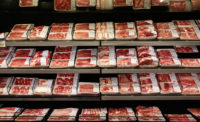DALLAS — Case-ready meat is rising in popularity. At the recent Annual Meat Conference (AMC) March 5 –8, panelists Stacey Couch, marketing development director, Retail and E-Commerce at Sealed Air Inc., Jamie Dik, segment business lead case ready at Cargill, and Catie Cantrell, director, meat operations at Heinen’s, all discussed the intricacies of case-ready meat.
The case-ready breakout session at the AMC first dove into the National Meat Case Study findings, led by Stacey Couch’s examination of these retail trends in the fresh meat case. The study found that case-ready packages, led by turkey and chicken, continued to rise across proteins. Seventy-six percent of SKUs are case-ready. The study also found that beef is most likely to be cut in store, but case-ready has risen to 71% of packages.
For packaging types, the study found that vacuum packaging is the most-used packaging, followed by PVC wrap. Vacuum packaging includes rollstock, saddle pack, shrink bag and vacuum skin. PVC still holds the majority of SKUS, 39%, and tray/lid packages are holding steady. Chub packaging is stable.
For tray types, the meat case study found that trayless packages, including semi-rigid, are now slightly ahead of foam — now, from two studies ago, rigid trays have doubled. The share of exact-weight packages has returned to 2015 levels.
Looking forward, case-ready can appeal to companies’ sustainability goals. This can allow for the growth of case-ready packages. Vacuum packaging can assist in increasing shelf life, so there is also room for growth for vacuum packaging.
After Stacey’s commentary, Jamie Dik from Cargill discussed case-ready in retail a bit further. Dik said retail is difficult now, and consumers want more — they want easy, fast meals, multicultural foods, and restaurant premium quality in their own homes. For Millenials and Gen Z consumers, they have had case-ready meats their entire lives. Ninety percent of these consumers shop from the self-serve case, and many buy online.
Case-ready has evolved in terms of quality in retail. For retailers looking to get into case-ready meats, Dik recommends thinking about strategy: case-ready can match the strategic approach of the specific retailer.
Next, Catie Cantrell from Heinen’s gave a real-world application of case-ready meats, using her own company’s perspective to answer the question: Why switch to case-ready?
Heinen’s made the change to case-ready because, as Cantrell said, evolution was inevitable. Due to rising costs, company growth and fewer Journeyman Cutters and highly experienced associates, case-ready was a solution for Heinen’s.
Cantrell said that Heinen’s supported the transition to case-ready at all levels, creating a united voice for the transition. The company wanted a purposeful transition and focused on gaining their customers’ trust, highlighting the benefits of case-ready to consumers.
There was certainly an adjustment period for Heinen’s, as Cantrell expanded upon. They had to rewrite the majority of their cut specs — with vacuum packaging, the product did not look familiar to their customers. They had to adjust their case lighting and found that LED worked better for them, but they are still adapting this aspect of the case. They went through multiple versions of packaging.
Now, Cantrell finds that case-ready is an overall win for Heinen’s. They are experiencing reduced shrink, improved product availability, growth allowance in a wider variety of cuts and improved utilization of labor, leading to labor savings. Case-ready also allows the company more risk with the ability to experiment with promotions. Heinen’s was well-positioned for the pandemic, and their case-ready meats were received well by consumers.
There are opportunities in case-ready, and interested retailers can use the above points to consider how making the transition can benefit their operations.




